
BUSHFOODS - AN ANNOTATED LIST:
FRUITS AND SEEDS EATEN BY
ABORIGINAL PEOPLE IN NORTHERN AUSTRALIA
Introduction
In recent years there has been an increased awareness of the importance of ethnobotanical
studies in Northern Australia. It is now recognised that information on traditional Aboriginal
plant use is a major part of our cultural heritage. However with the increasing dependence
upon European type foods and forced sedentary life styles, much of this traditional or old
time knowledge is being lost. In some areas there is an urgent need to document this information before it is lost altogether.
Newly researched data on bush foods can provide valuable information on the choice of species for trial as new commercial crops. Many species commonly eaten by Aboriginal people are untried in cultivation and some have great potential for the horticultural industry, eg. Horsfieldia australiana and Terminalia ferdinandiana, highly valued for their fruits.
This paper outlines some of the more commonly utilized fruit and seeds in Northern Australia, much of which comes from recent survey work. Major references have been viewed and information on 132 species or forms are presented. The list presented is not comprehensive, representing some of the more commonly utilized foods eaten by Aboriginal people in Northern Australia. Many more species have been recorded as eaten and undoubtedly many more will be documented in the future by further field work.
Note: Caution should be shown when collecting some of the species described in this paper, as unless prepared properly, they can be highly toxic and may cause serious illness. One should be sure of the identification of the plant concerned and should consult the references cited for full preparation procedures.
The species used are listed alphabetically by botanical name.
Acacia auriculiformis "Black Wattle" Mimosaceae
The seeds are ground to flour to make 'Johnny cakes' or damper (15).
A. difficilis Mimosaceae
The seeds are eaten (2).
A. holosericea "Soap Bush" Mimosaceae
The seeds are collected, ground on stones and made into a flour. The flour is made into a damper or flat bread that is cooked on hot coals protected or wrapped in leaves (2,8,10,15).
A. torulosa Mimosaceae
The seeds are ground to flour for damper. The young green fruit and seeds may be eaten raw (15).
A. tumida Mimosaceae
The seed pod is eaten raw or the seeds can be lightly roasted on hot ashes (3).
A. umbellata Mimosaceae
The seeds are made into a flour for damper (15).
Adansonia gregorii "Boab/Bottle Tree" Bombacaceae
The pith inside the fruit is eaten raw or if it is hard it can be added to water with a little
sugar to make a thirst quenching drink (3,10,11).
Aidia cochinchinensis Rubiaceae
Edible fruits (7).
Ampelocissus acetosa "Bush Grape" Vitaceae
The fruits are eaten raw when ripe (Black). They have a hot taste and are considered to be
"cheeky" (3,4,6,7,10,11,2,14,16,17).
A. frutescens "Bush Grape" Vitaceae
The fruits are eaten raw when ripe (black). They taste cheeky or hot (10).
Amyema bifurcatum "Mistletoe" Loranthaceae
The fruits are eaten raw when yellow and ripe (15,16).
A. sanguineum "Mistletoe" Loranthaceae
The fruits are eaten raw when ripe (3).
Antidesma ghaesembilla "Black Currant" Euphorbiaceae
The fruits are eaten raw when purple and ripe (1,2,3,5,6,7,11,16,17).
A. parvifolium "Bush Currant" Euphorbiaceae
The fruits are eaten raw when black and ripe (7,13).
Avicennia marina "White Mangrove" Verbenaceae
The fruits are roasted on hot ashes then eaten. These fruits are not eaten much nowadays.
Some bury the seed in mud for 3 days then boil before eating to remove any toxins
(8,9,10,12,17).
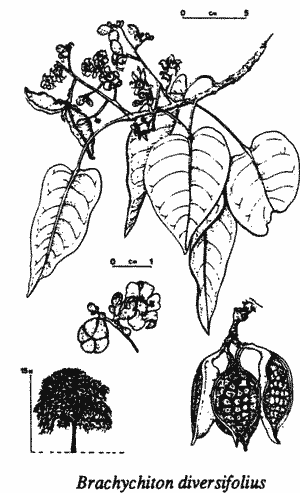
Brachychiton diversifolius "Kurrajong" Sterculiaceae
The fruits are roasted on hot ashes to remove the irritant hairs that surround the seeds. The
seeds are then picked out and eaten (2,3,8,10,11,12,15,16).
B. megaphyllus "Red Flowered Kurrajong" Sterculiaceae
Used in the same way as B. diversifolius (2,3,5,10,11,12,14,16).
B. multicaulis "Wild Curry Kurrajong" Sterculiaceae
The seeds are ground into a flour to make a damper (15).
B. spectablis "Kurrajong" Sterculiaceae
Used in the same way as B. diversifolius (10).
B. viscidulus "Kurrajong" Sterculiaceae
Used in the same way as B. diversifolius (11).
Bridellia tomentosa Euphorbiaceae
The fruits are eaten raw when ripe (black) (2,7).
Buchanania arborescens "Green Plum" Anarcardiaceae
The fruit are considered edible (2).
Buchanania obovata "Green Plum" Anarcardiaceae
The fruits are eaten raw when yellow and ripe; often they are collected from the ground
(1,2,3,5,6,7,9,10,11,12,13,14,16,17).
Canarium australianum "Canarium" Burseraceae
The fruits are collected from the ground, they are cracked open and the seeds eaten raw
(3,4,5,9,10,12,17).
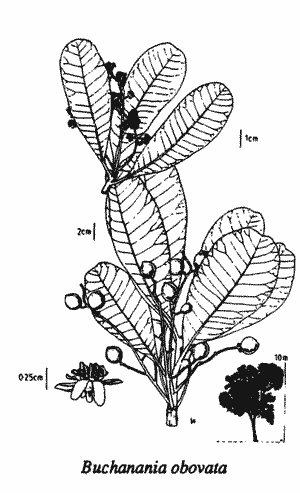
Canthium lucidum Rubiaceae
Edible fruits when ripe (1,2,7).
Capparis lasiantha "Split Jack" Capparaceae
The whole fruit is eaten raw, including seeds. Tastes very sweet and is highly sought after
(10,11,15,16).
C. umbonata "Wild Orange" Capparaceae
The fruit is considered good food, eaten raw when soft and ripe (3,10,11,12,15,16).
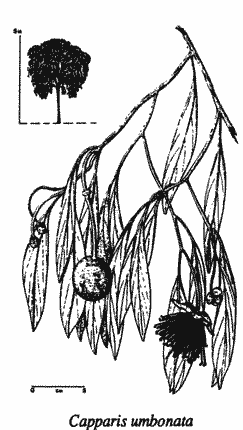
Carallia brachiata Rhizophoraceae
The small fruit is eaten raw when red and ripe (1,7,10,12,13,14).
Carissa lanceolata "Conker Berry" Apocynaceae
The fruits are eaten raw when ripe (soft and black). A highly prized food
(8,10,11,15,16).
Cassytha filiformis "Dodder" Lauraceae
The fruits are eaten raw when ripe (clear/translucent). They are highly regarded as a food
source (1,5,6,7,8,9,10,12,16,17).
Cayratia trifolia "Native Grape" Vitaceae
Fruits eaten raw when black (7,10,16,17).
Celtis philippensis "Celtis" Ulmaceae
Edible fruits when red and ripe (5,6,14).
Cordia subcordata Boraginaceae
The seeds are edible (1).
Corypha elata "Corypha Palm" Arecaceae
Some say the seed is edible (5,14).
Cucumis melo "Wild Cucumber" Curcurbitaceae
The fruits are eaten raw after rubbing off the white bloom on the outside of the skin
(3,10,11,15,16,17).
Cycas angulata "Cycad" Cycadaceae
The ripe fruits are soaked in running water for 2- 3 days to remove any toxins, they are
then ground into a flour to make a damper (6,10).
C. armstrongii "Cycad" Cycadaceae
The ripe fruits are edible only after thorough preparation involving crushing and soaking
in running water. The mixture is then thoroughly cooked in ashes to make a damper
(1,2,4,5,6,7,10,12,17).
Cynanchum pedunculatum Asclepiadaceae
The young fruits are eaten after roasting on hot coals (2,3,10,12).
Dillenia alata Dilleniaceae
The seed is eaten raw (6).
Diospyros humilis "Ebony" Ebonaceae
The fruit is eaten raw when red and ripe (16).
Drypetes lasiogyna Euphorbiaceae
The fruits are eaten raw when ripe (red); tastes very sweet (2,4,5,6,10).
Elaeocarpus arnhemicus Elaeocarpaceae
The fruit is edible (6).
Erythroxylum ellipticum Erythroxylaceae
The fruits are eaten raw when red and ripe (10,11,16).
Eucalyptus confertiflora Myrtaceae
The seeds are edible (4).
E. ferruginea "Bloodwood" Myrtaceae
The seeds are edible (7).
E. miniata "Woollybutt" Myrtaceae
The seeds are edible (7).
Exocarpos latifolius "Native Cherry" Santalaceae
The fruits are eaten raw when red and ripe (4,10,12).
Ficus benjamina "Weeping Fig" Moraceae
The fruits are edible (14).
F. coronulata "River Fig" Moraceae
The fruits eaten raw when ripe and soft. (1,10,11,13,16).
F. hispida "Fig" Moraceae
The fruits are eaten raw when yellow and ripe (6,16).
F. leucotricha "Rock Fig" Moraceae
The fruits are edible (2).
F. opposita "Sandpaper Fig" Moraceae
The fruits are eaten raw when ripe (black); they are considered good tucker
(3,5,6,7,8,9,10,11,12,16,17).
F. platypoda "Rock Fig" Moraceae
The fruits are eaten raw when ripe (yellow/red). Dried fruits can be collected from the
ground, ground to flour then made into a paste and eaten or rolled into a ball re-dried and
stored for later use (1,2,3,4,5,6,7,10,11,14,16).
F. racemosa "River Fig" Moraceae
The fruits are eaten raw when ripe (red); often they are collected from the ground
(1,2,3,7,10,11,13,14,16).
F. scobina "Sandpaper Fig" Moraceae
The fruits are eaten raw when black and soft (1,2,5,7,10,13).
F. virens "Banyan" Moraceae
The fruits are eaten raw when white and soft (2,5,6,10,12,13).
Flacourtia territorialis Flacourtiaceae
The fruits are eaten raw when ripe (red). The many fine seeds are spat out (2,10).
Flagellaria indica "Supple Jack" Flagellariaceae
The fruits are eaten and the seeds discarded (2).
Flueggea virosa "White Currant" Euphorbiaceae
The fruits are eaten raw when ripe (white). This is a highly regarded food (1,2,3,5,6,7,8,
9,10,11,12,13,14,15,16,17).
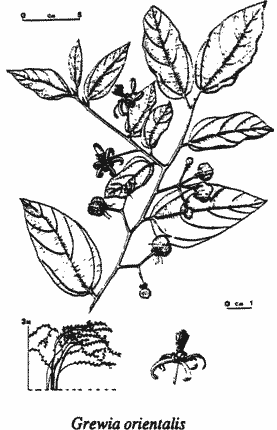
Ganophyllum falcatum "Termite Tree" Sapindaceae
The fruit is edible (6).
Gardenia megasperma "Gardenia" Rubiaceae
The fruit is edible (2).
G. pyriformis Rubiaceae
The flesh inside the fruit is eaten when soft and ripe (8).
Grevillea decurrens Proteaceae
The seeds are eaten raw (7).
G. heliosperma Proteaceae
The seeds are eaten raw (1,2,4,7).
Grewia asiatica Tiliaceae
The fruit is eaten raw when ripe (black); very sweet (10).
G. breviflora Tiliaceae
The fruits are eaten raw when black. (10,11).
G. orientalis Tiliaceae
The fruit is eaten raw when black and soft (3,10,12,16).
G. retusifolia "Emu Berry" Tiliaceae
The fruits are eaten raw when ripe (brown). Children love this fruit (1,3,4,5,6,7,9,11,12,
14,15,16,17).
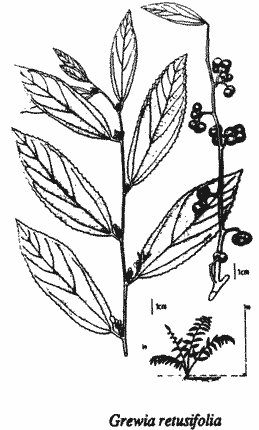
Hakea arborescens "Hakea" Proteaceae
The seeds are edible (6).
Helicia australasica Proteaceae
The seeds are eaten raw (1,7).
Hibiscus meraukensis Malvaceae
The seeds are eaten raw (6).
Horsfieldia australiana Myristicaceae
The seeds are eaten raw (7).
lxora klanderana "Native Ixora" Rubiaceae
The fruit are edible when black (5,6).
I. tomentosa Rubiaceae
The fruit is eaten raw (2,7).
Leea rubra "Leea" Leeaceae
Fruits eaten raw when black and soft (1,3,5,7,10,13,17).
Livistona humilis "Fan Palm" Arecaceae
The fruits are edible (1,2,14).
Lysiantha spathulata "Mistletoe" Loranthaceae
The fruits are eaten raw when yellow and ripe (15,16).
Malasia scandens Moraceae
The fruit is eaten raw when black (1,5).
Malotus nesophilus Euphorbiaceae
The fruit are eaten when white (2,5,6).
Marsdenia australis "Bush Banana" Asclepiadaceae
Young fruits are eaten after they have been lightly roasted on hot ashes (10,11).
M. viridiflora "Wild Banana" Asclepiadaceae
The young fruits are eaten when green but soft (8,16).
Melastoma polyanthum "Native Lasiandra" Melastomataceae
The fruits are eaten raw (6).
Mimusops elengi "Mimusops" Sapotaceae
The fruit is eaten raw when red (4,5,6).
Momordica balsamina Cucurbitaceae
The fruits are eaten raw when red; the many black seeds are spat out (10,11).
Morinda citrifolia "Stinking Cheesefruit" Rubiaceae
The fruits are eaten raw when ripe and soft (4,5,6,7,10,12,13).
Nauclea orientalis "Leichhardt Pine" Rubiaceae
The fruits are eaten raw when ripe and soft (1,2,7,10,11,13,16).
Nelumbo nucifera "Red/Lotus Lily" Nelumboniaceae
The whole fruiting capsule is eaten raw or after roasting on hot ashes (10,16).
Nymphea gigantea "Lily" Nymphaeaceae
The seeds are ground to a flour to make a damper (3,10).
N. macrosperma "Lily" Nymphaeaceae
The fruit is eaten raw or after roasting on hot ashes. The seed are ground to a flour to make
a damper (2,10,11,16).
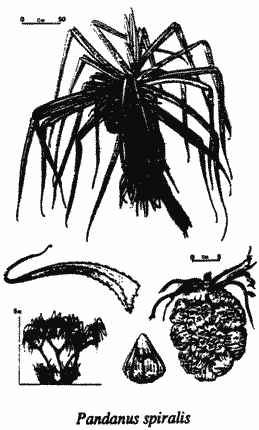
N. violacea "Lily" Nymphaeaceae
Used the same way as N. macrosperma (2,16).
Opilia amentacea "Oplia" Opiliaceae
The fruits are eaten raw when yellow to red (1,2,7,10,11,14,15).
Osbeckia australiana Melastomataceae
The fruits are eaten raw (7).
Pandanus basedowii "Rock Pandanus" Pandanaceae
The seeds are edible (1,2,7,13).
P. spiralis "Screw Palm" Pandanaceae
The red/yellow flesh at the base of the fruits is eaten raw. The seeds are eaten raw or
roasted. A highly prized food source (1,2,4,5,6,7,8,9,10,11,12,13,14,16,17).
Paramignya trimera Rutaceae
The fruit is eaten raw when red (10,17).
Passiflora foetida "Wild Passionfruit" Passifloraceae
The fruits are eaten raw when ripe (yellow). Unripe fruits are considered poisonous (1,2,
3,5,6,7,10,11,12,13,15,16,17).
Persoonia falcata "Milky Plum" Proteaceae
The fruits are eaten raw when yellow (1,3,4,5,6,7,8,9,10,12,16,17).
Physalis minima "Gooseberry" Solanaceae
The fruit is eaten raw when ripe purple (2,5,10,11,16).
Planchonella pohlmania "Big Green Plum" Sapotaceae
The fruit is edible (5).
Planchonia caryea "Cocky Apple" Lecythidaceae
The fruits are eaten raw when ripe soft but still green (1,3,5,6,7,9,10,14,17).
Pogonolobus reticulatus "Colour Root" Rubiaceae
The fruit is eaten raw when purple (1,7,10).
Portulaca oleracea "Pig Weed" Portulacaceae
The seeds are winnowed and ground to a flower to make a damper (10,15).
Pouteria sericea "Black Plum" Sapotaceae
The fruits are eaten raw when ripe (purple); a highly prized food (2,3,4,5,6,7,8,9,10,11,
12,13,14,17).
Santalum album "Sandalwood" Santalaceae
The fruit is edible (5). [Editor's Note, 2011: I believe this is a wrong identification - it should be Santalum acuminatum, Quandong. S. album, Indian Sandalwood, is an Indian species used for its valuable oil.]
S. lanceolatum "Sandalwood" Santalaceae
The fruits are eaten raw when purple (8,10).
Semecarpus australiensis "Native Cashew" Anacardiaceae
The seeds are eaten after the fruits have been lightly roasted and the poisonous section
discarded. Contact with most parts of this plant will cause blisters and welts (5,10,14).
Smilax australis "Smilax" Smilacaeceae
The fruits are eaten raw when black (4,5,6,10,17).
Solanum cunninghamii "Wild Tomato" Solanaceae
The skin and rind of the fruit are eaten but not the flesh or seeds (8).
S. ellipticum "Wild Tomato" Solanaceae
The fruits are eaten raw when ripe (10,15).
S. tumulicola "Wild Tomato" Solanaceae
The fruit is eaten, but not the skin (15).
Sterculia quadrifida "Bush Peanut" Sterculiaceae
The seeds are eaten raw when ripe (black), the black seed coat is peeled off or spat out. A
highly sought after food (1,2,5,6,7,10,12,17).
Syzygium angophoroides Myrtaceae
The fruit is eaten raw when purple (2).
S. armstrongii "White Bush Apple" Myrtaceae
The fruit is eaten raw when white (1,2,6,7,10,12,13).
S. eucalyptoides ssp. bleeseri "White Bush Apple" Myrtaceae
The fruit is eaten raw when white (1,2,10,12,13,14).
S. eucalyptoides ssp. eucalyptoides "Bush Apple" Myrtaceae
The fruit is eaten raw when white (1,2,7).
S. forte "Wild Apple" Myrtaceae
The fruit is eaten raw when white (1,7).
S. minutuliflorum Myrtaceae
Edible fruit when white (7).
S. nervosum Myrtaceae
Edible fruit when black (2,7).
S. suborbiculare "Red Bush Apple" Myrtaceae
The fruit is eaten raw when red (1,2,4,5,6,7,9,10,12,13,14,16,17).
Tacca leontopetaloides "Cheeky Yam" Taccaceae
The fruits are eaten raw when ripe; the seeds can be eaten or spat out (10,12,17).
Tamarindus indica "Tamarind" Caesalpiniaceae
The fruit pulp is eaten raw when soft and brown (4,5,6,10,14,16,17).
Terminalia arostrata "Nut Wood" Combretaceae
The seeds are eaten raw; the fruits are collected from the ground and are cracked between
stones (10,11,16).
T. carpentariae "Wild Peach" Combretaceae
The fruit is eaten raw when ripe (yellow); considered sweet and a highly sought after food
(2,5,10,16,17).
T. erythrocarpa Combretaceae
The fruits are eaten raw when purple (16).
T. ferdinandiana "Billy Goat Plum" Combretaceae
The fruit is eaten raw when ripe (yellow/pale green). Often they are collected from the
ground (1,2,4,5,7,8,9,10,11,12,13,16,17).
T. grandiflora "Nut Tree" Combretaceae
Used in the same way as T. arostrata (2,3,5,6,7,10,14,17).
T. petiolaris Combretaceae
The fruit is eaten raw when purple (8).
T. sericocarpa Combretaceae
The fruits are edible (1,7,13).
T. volucris "Wild Peanut" Combretaceae
The seed is taken out of the fruit and eaten (15).
Vitex acuminata "Black Plum" Verbenaceae
Edible fruit when black (2,7).
Vitex glabrata "Black Plum" Verbenaceae
The fruits are eaten raw when ripe (black), often they are collected from the ground.
Sometimes the fruit is crushed in water to make a sweet liquid drink (1,2,3,4,5,6,7,10,11,12
,13,14,16).
Ziziphus quadrilocularis Rhamnaceae
The fruits are eaten raw when red (10,11).
REFERENCES
1. Altman, J.C. (1981). An inventory of flora and fauna utilised by eastern Gunwinggu in the Mann/Liverpool region, north central Arnhem Land. Australian Institute of Aboriginal Studies (unpublished).
2. Chaloupka, G. and Giuliani, P. (1984). 'Gundulk Abel Gundalg, Mayali Flora'. Northern Territory Museum of Arts and Sciences, Darwin (unpublished).
3. Crawford, I.M. (1982). Traditional Aboriginal Plant Resources in the Kalumburu Area: Aspects in Ethno-economics. Records of the Western Australia Museum; Supplement 15, Perth.
4. Dunlop, C.R. et al. (1976). A botanical survey of Elcho Island, July 1975. Northern Territory Botanical Bulletin No. 1:1-61. Northern Territory Department of Primary Production, Darwin.
5. Galpagalpa, J. et al (1984). 'Dhuwal djambarrpuyngudharuk malagamayali' (Djambarrpuyngu word list). Yirrkala literature Production Centre, Yirrkala.
6. Levitt, D. (1987). Plants and People; Aboriginal uses of plants on Groote Eylandt. Australian Institute of Aboriginal Studies, Canberrra.
7. Russell-Smith, J. (1985). Studies in the Jungle; People, fire and monsoon forest. Archeological Research in Kakadu National Park. Australian National Parks and Wildlife Service Special Publication 13: 241-267.
8. Lands, M. (1987). Mayi. Some Bush fruits of Dampierland. Magabala Books, Broome.
9. Smith, M. and Kalotas, A. (1985). Bardi Plants; an annotated list of plants and their use by the Bardi Aboriginal of Dampier. Records of the Western Australian Museum 12(3):317-359.
10. Smith, N.M. (1991). Ethnobotanical Field Notes from the Northern Territory, Australia. Journal of Adelaide Botanic Gardens 14(1):1-65.
11. Smith, N.M., Wididburu, B., Harrington, R.N. and Wightman, G.M. (1990). Ngarinyman Ethnobotany. Aboriginal Plant use from the Victoria River Area, Northern Australia. Northern Territory Botanical Bulletin No. 16:1-64. Conservation Commission of the Northern Territory, Palmerston.
12. Smith, N.M. and Wightman G.M. (1993). Ethnobotanical Notes From Belyuen, Northern Territory Australia. Northern Territory Botanical Bulletin No.10: 1-31. Conservation Commission of the Northern Territory, Palmerston.
13. Smyth, D. and von Sturmer, J. (1981). The use of plants by the Aboriginal people in the Oenpelli region of western Arnhem Land. Australian Institute of Aboriginal Studies, Canberra (unpublished).
14. Specht, R.L. (1958). An introduction to the ethnobotany of Arnhem Land. In: R.L. Specht and C.P. Mountford (Eds.), Records of the American-Australian Scientific Expedition to Arnhem Land. 3:479,-503. Melbourne University Press, Melbourne.
15. Wightman, G.M., Dixon D., Williams L. and Dalywaters I. (1992). Mudburra Ethnobotany. Aboriginal plant use from Kulumindini (Elliott) Northern Australia. Northern Territory Botanical Bulletin No. 14: 1-44. Conservation Commission of the Northern Territory, Palmerston.
16. Wightman, G.M., Roberts J.G. and Williams L. (1992). Mangarrayi Ethnobotany. Aboriginal plant use from the Elsey Area, Northern Australia. Northern Territory Botanical Bulletin No. 15:1-59. Conservation Commission of the Northern Territory, Palmerston.
17. Wightman, G.M. and Smith, N.M. (1989). Ethnobotany, Vegetation and Floristics of Milingimbi, Northern Australia. Northern Territory Botanical Bulletin No. 6:1-37. Conservation Commission of the Northern Territory, Australia.
DATE: July 1993
* * * * * * * * * * * * *
